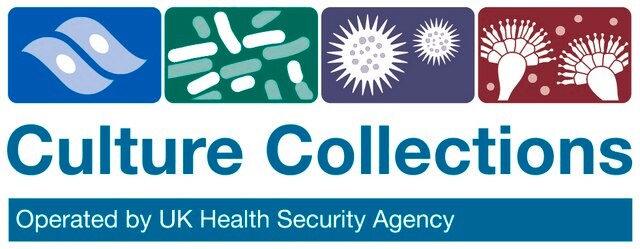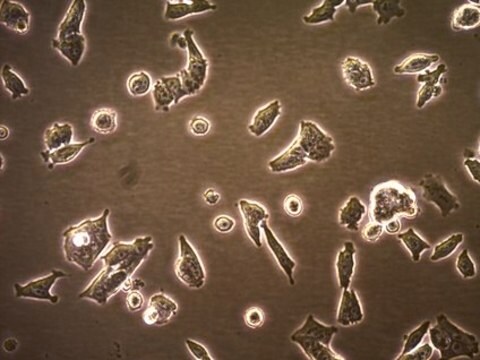SCC147
TPC-1 Human Papillary Thyroid Carcinoma Cell line
TPC-1 human papillary thyroid carcinoma cell line is a highly characterized model for thyroid cancer research.
Synonym(s):
TPC1
Sign Into View Organizational & Contract Pricing
All Photos(1)
About This Item
UNSPSC Code:
41106514
eCl@ss:
32011203
Recommended Products
biological source
human
technique(s)
cell culture | mammalian: suitable
shipped in
ambient
Related Categories
General description
TPC-1 is a widely published and well-characterized cell line isolated from a papillary thyroid carcinoma of a female patient (6). The genome of TPC-1 contains the RET/PTC1 rearrangement found in approximately 20% of sporadic papillary carcinomas in adults (2). TPC-1 harbors a silent polymorphism in H-RAS, and is wild-type for sequences of BRAF, CNBB1, EGFR, K-RAS, RAF-1, PI3K, and TRHB (3). TPC-1 cells produce thyroglobulin (Tg) as well as expressing the thyroid differentiation marker PAX8 and the tumor progression factor podoplanin (4). In addition, TPC-1 has been utilized as an in vitro model for human cytomegalovirus latency, a potential contributor for certain human cancers (5). The TPC-1 cell line is thus an excellent system for investigating mechanisms of thyroid carcinogenesis.
Thyroid cancer is the most prevalent endocrine carcinoma, with a rapidly increasing occurrence in many countries. Human models of differentiated thyroid cancer are highly valuable for assessing the pathways and mechanisms that contribute to thyroid carcinogenesis.
References:
1. Davies L, Welch HG (2006). Increasing incidence of thyroid cancer in the United States, 1973-2002. JAMA 295(18): 2164-2167.
2. Pilli T, et al. (2009). Potential utility and limitations of thyroid cancer cell lines as models for studying thyroid cancer. Thyroid 19(12): 1333-1342.
3. Meireles AM, et al. (2007). Molecular and genotypic characterization of human thyroid follicular cell carcinoma-derived cell lines. Thyroid 17(8): 707-715.
4. Rudzińska M, et al. (2014). The role of podoplanin in the biology of differentiated thyroid cancers. PLoS One 9(5): e96541.
5. Tanaka J, et al. (1987). Establishment and biological characterization of an in vitro human cytomegalovirus latency model. Virology 161(1): 62-72.
6. Ishizaka Y, et al. (1989). Presence of aberrant transcripts of ret proto-oncogene in a human papillary thyroid carcinoma cell line. Jpn J Cancer Res 80(12): 1149-1152.
References:
1. Davies L, Welch HG (2006). Increasing incidence of thyroid cancer in the United States, 1973-2002. JAMA 295(18): 2164-2167.
2. Pilli T, et al. (2009). Potential utility and limitations of thyroid cancer cell lines as models for studying thyroid cancer. Thyroid 19(12): 1333-1342.
3. Meireles AM, et al. (2007). Molecular and genotypic characterization of human thyroid follicular cell carcinoma-derived cell lines. Thyroid 17(8): 707-715.
4. Rudzińska M, et al. (2014). The role of podoplanin in the biology of differentiated thyroid cancers. PLoS One 9(5): e96541.
5. Tanaka J, et al. (1987). Establishment and biological characterization of an in vitro human cytomegalovirus latency model. Virology 161(1): 62-72.
6. Ishizaka Y, et al. (1989). Presence of aberrant transcripts of ret proto-oncogene in a human papillary thyroid carcinoma cell line. Jpn J Cancer Res 80(12): 1149-1152.
Cell Line Description
Cancer Cells
Application
Research Category
Cancer
Oncology
Cancer
Oncology
TPC-1 human papillary thyroid carcinoma cell line is a highly characterized model for thyroid cancer research.
This product is intended for sale and sold solely to academic institutions for internal academic research use per the terms of the “Academic Use Agreement” as detailed in the product documentation. For information regarding any other use, please contact licensing@emdmillipore.com.
Quality
• Each vial contains ≥ 1X10⁶ viable cells.
• Cells are tested negative for infectious diseases by a Human Essential CLEAR panel by Charles River Animal Diagnostic Services.
• Cells are negative for mycoplasma contamination.
• Cells are verified to be of human origin and negative for inter-species contamination from mouse, rat, chinese hamster, Golden Syrian hamster, and non-human primate (NHP) as assessed by a Contamination CLEAR panel by Charles River Animal Diagnostic Services.
• Each lot of cells is genotyped by STR analysis to verify the unique identity of the cell line.
• Cells are tested negative for infectious diseases by a Human Essential CLEAR panel by Charles River Animal Diagnostic Services.
• Cells are negative for mycoplasma contamination.
• Cells are verified to be of human origin and negative for inter-species contamination from mouse, rat, chinese hamster, Golden Syrian hamster, and non-human primate (NHP) as assessed by a Contamination CLEAR panel by Charles River Animal Diagnostic Services.
• Each lot of cells is genotyped by STR analysis to verify the unique identity of the cell line.
Storage and Stability
Store in liquid nitrogen. The cells can be cultured for at least 10 passages after initial thawing without significantly affecting the cell marker expression and functionality.
Disclaimer
Unless otherwise stated in our catalog or other company documentation accompanying the product(s), our products are intended for research use only and are not to be used for any other purpose, which includes but is not limited to, unauthorized commercial uses, in vitro diagnostic uses, ex vivo or in vivo therapeutic uses or any type of consumption or application to humans or animals.
Storage Class Code
12 - Non Combustible Liquids
WGK
WGK 1
Flash Point(F)
Not applicable
Flash Point(C)
Not applicable
Certificates of Analysis (COA)
Search for Certificates of Analysis (COA) by entering the products Lot/Batch Number. Lot and Batch Numbers can be found on a product’s label following the words ‘Lot’ or ‘Batch’.
Already Own This Product?
Find documentation for the products that you have recently purchased in the Document Library.
Chang Liu et al.
Frontiers in oncology, 9, 1475-1475 (2020-02-18)
Patients with advanced thyroid carcinoma have poor prognosis with low overall survival. Unfortunately, the underlying mechanisms of thyroid carcinoma progression remain unclear. The elevated expression of thymidine kinase 1 (TK1) has been implicated in the progression of thyroid carcinoma, while
Federica Panebianco et al.
Cancer medicine, 8(13), 5831-5839 (2019-08-14)
Reactivation of telomerase reverse transcriptase (TERT) is an important event in cancer. Two hotspot mutations in the TERT promoter region, c.-124C > T (C228T) and c.-146C > T (C250T), occur in various cancer types including thyroid cancer. They generate de novo binding sites for
Our team of scientists has experience in all areas of research including Life Science, Material Science, Chemical Synthesis, Chromatography, Analytical and many others.
Contact Technical Service



